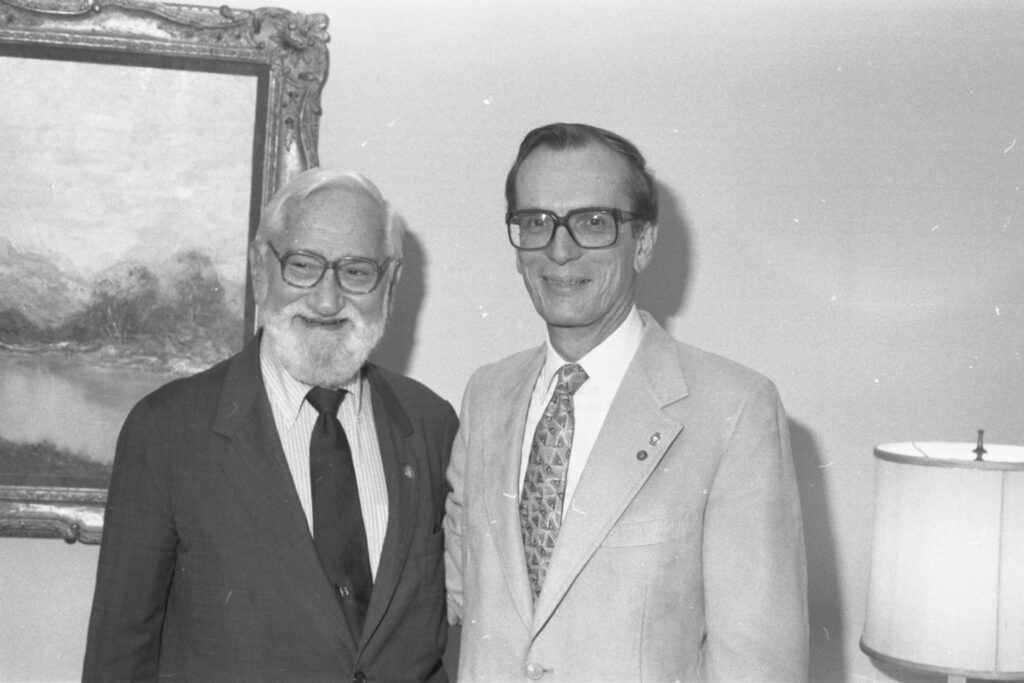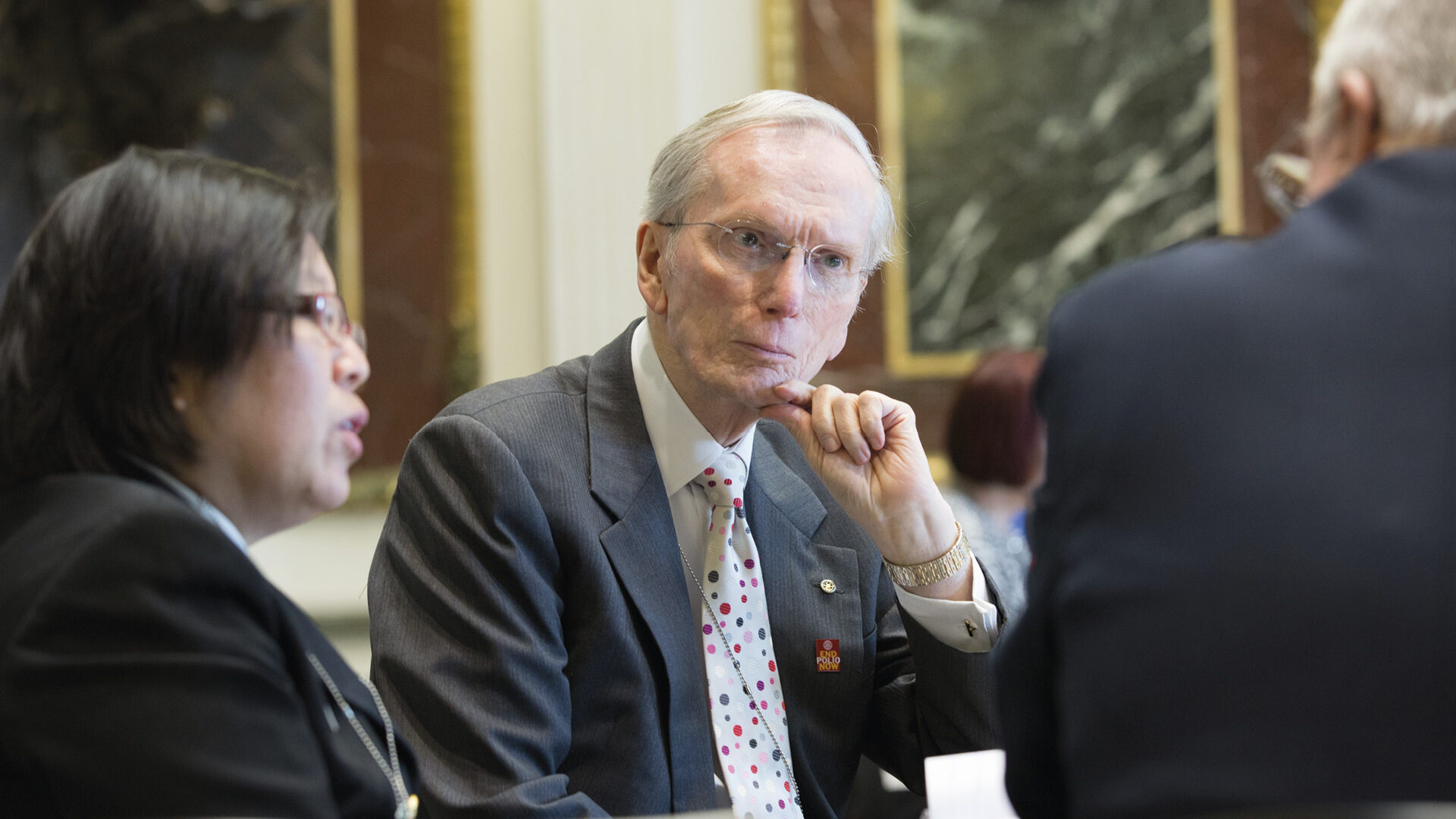Inspired by Australian Rotary International President Sir Clem Renouf, then District Governor John Sever convinced Rotary and the world to believe in polio eradication. The infectious disease specialist died in April at the age of 92. Here we pay tribute to his pivotal role in polio eradication.
By Peter Ross Range
It was April 1979, and Clem Renouf, then RI president, was leafing through a copy of Reader’s Digest on his flight from the Philippines. In the pages of the magazine, he read about how smallpox had been eradicated for little more than the cost of the two Australian naval vessels he’d seen the day before. He had just been visiting Manila to formalise agreements to launch the first project under The Rotary Foundation’s Health, Hunger and Humanity Grants program, known as 3-H, and now Clem was wondering whether these new grants could enable Rotary to tackle another disease with similar success. He called his friend John Sever.
John was a Rotary district governor in the Washington, D.C., area and head of the infectious diseases branch of the National Institute of Neurological and Communicative Diseases and Stroke at the National Institutes of Health. Clem had met him six months prior, when John had arranged for him to speak with contacts in the US State Department before his first major trip as Rotary president to West Africa.
“I didn’t expect a doctor to be so businesslike, but he changed that misconception,” Clem said. “So, when I had this bright idea, it was natural I’d seek John’s advice.”
As a researcher, John was immersed in studies of infectious diseases that affect children, such as measles, and vaccine development. His professional goal was to identify new causes of disease and bring vaccines to the children of the world. He was keenly aware that smallpox – a scourge especially rampant in developing countries – had just been eradicated, the first disease to be halted through a concerted public health effort.
John was also friends with Jonas Salk and Albert Sabin, the men who had revolutionised public health with their development of the polio vaccines in the 1950s and ’60s. The vaccines were already stopping polio in the developed world; the United States would see its last case of endemic polio later in 1979. John recognised that Albert’s oral vaccine, available for only four cents per dose, had the potential to save more than 350,000 children per year all over the world from the debilitating disease, if only someone could organise the effort.
After Clem’s phone call about which diseases to target, John consulted with Albert. A few weeks later, he mailed Clem a letter with his recommendation: “If a single vaccine were to be selected for the 3-H program, I would recommend poliomyelitis.”

PICTURED: John Sever, right, with Albert Sabin at a Polio 2005 Committee meeting in 1984.
The 3-H program was in its infancy. It was the first time Rotary had committed to new projects beyond the capacity of any one club or district. While the first project, which began in September 1979, focused on bringing polio vaccine to children in the Philippines, the program as a whole was intended to improve health, relieve hunger, and enhance human and social development. Rotary had never had a single corporate cause of this kind.
“The important thing was to get the polio vaccine from the manufacturers to the people who needed it,” John recalled. “I knew that Rotarians were a big international army of volunteers. They could work with the governments of the world to assist with immunisation and provide financial support and social mobilisation.”
Clem credited John, a member of the Rotary Club of Potomac, Maryland, US, for convincing Rotary’s leaders that the organisation could succeed in tackling the disease.
“Most would have dismissed it as an impossible dream, beyond our capacity financially or organisationally, as did many former leaders,” Clem said. “But here was a Rotarian uniquely qualified – a senior scientist with an appreciation of Rotary’s potential, who by virtue of his reputation personally and professionally was able to persuade the 1979-80 Board to adopt the goal of a polio-free world as the major emphasis of the 3-H program.”
The son of a Chicago physician, John remembers his father caring for children with polio. At that time, he said, “you could buy polio insurance for your newborn.”
He recalls Sundays in Chicago, when families would go to particular schools or other public facilities for vaccine clinics.
“That was called Sabin on Sunday – SOS – the equivalent to what we now call National Immunisation Days.”
John trained at Northwestern University as a paediatrician and earned a PhD in microbiology. At the NIH and later at the Children’s National Medical Centre, he worked as a scientist who also saw patients, a vaccine expert who understood social outreach, and a medical administrator who knew the politics of public health.
“Here was a Rotarian uniquely qualified – a senior scientist with an appreciation of Rotary’s potential, who by virtue of his reputation personally and professionally was able to persuade the 1979-80 Board to adopt the goal of a polio-free world as the major emphasis of the 3-H program.”
These skills would come into play over the next three decades as John, along with many other Rotary members, inspired and led the global health community in its dogged struggle against a paralysing disease.
When 1984-85 RI President Carlos Canseco took office, he appointed a committee to create a long-term strategy to immunise all the children of the world against polio by Rotary’s 100th anniversary. John served as chair of this Polio 2005 Committee, which developed the plan for Rotary to provide polio vaccines and support to any country that needed assistance. (In 1995, he was appointed to that group’s present incarnation, the International PolioPlus Committee, on which he served as vice chair of medical affairs since 2006.)
Along with Carlos and John, Albert and Herbert Pigman, then RI general secretary, served as members of the Polio 2005 Committee.
“It was these four men, I believe, who were primarily responsible for translating a dream into reality,” Clem said.
In his role, John became Rotary’s point person on the polio project and spokesperson to the outside world. One of his first challenges was to create a partnership with the World Health Organisation. Officials at the organisation’s headquarters were sceptical, unsure that Rotary members knew what they were up against.
“With Carlos, we had to hold a lot of cocktail hours with WHO members at the InterContinental Hotel in Geneva,” John said. “They received us politely, but they didn’t think any non-governmental organisation could go the distance.”
With John’s help, Rotary received a special designation as a non-governmental organisation affiliated with WHO and forged an official partnership with the agency. That partnership, now known as the Global Polio Eradication Initiative, includes the spearheading partners WHO, Rotary International, the US Centres for Disease Control and Prevention, and UNICEF. Other important sources of support include the Gates Foundation and national governments.
John was a clear and direct spokesperson, as befits a dedicated scientist, but he was also modest. When he received praise for his vision and years of non-stop work on behalf of polio eradication, he waved it away like a village health worker swatting at flies.
“It wasn’t just me,” he insisted. “Many, many others were involved.”
John’s dual role as a Rotarian and respected scientist proved “invaluable” to the Global Polio Eradication Initiative, said Hamid Jafari, the campaign’s director at WHO.
“He was a bridge between the world of science and the technical areas of public health that WHO and CDC scientists deal with, and the world of Rotary. Rotarians looked up to him for validation of the science, of the technical strategies, of the research we have.”
“The polio eradication program is where it is today because of the contribution of some remarkable people – none more so than John,” said Clem.
“At a crucial time, he had the knowledge and experience and ability to breathe life into a nebulous idea and provide the leadership needed to reach a historic goal. I just hope he is onstage when that announcement is made, to receive the recognition he deserves.”
Sadly, despite making it into their 90s, neither Sir Clem Renouf nor John Sever were on stage to experience such a momentous occasion. Sir Clem passed away on June 11, 2020, and John passed on April 25, 2024. Celebrate their life with a gift to end polio at rotary.org/donate.
*This article was first published in the January 2014 edition of Rotary magazine.
MAIN PICTURE: John Sever was one of 12 Rotarians from across the United States honoured for their volunteer work during Rotary Day at the White House in 2013. (Photo: Monika Lozinska)
